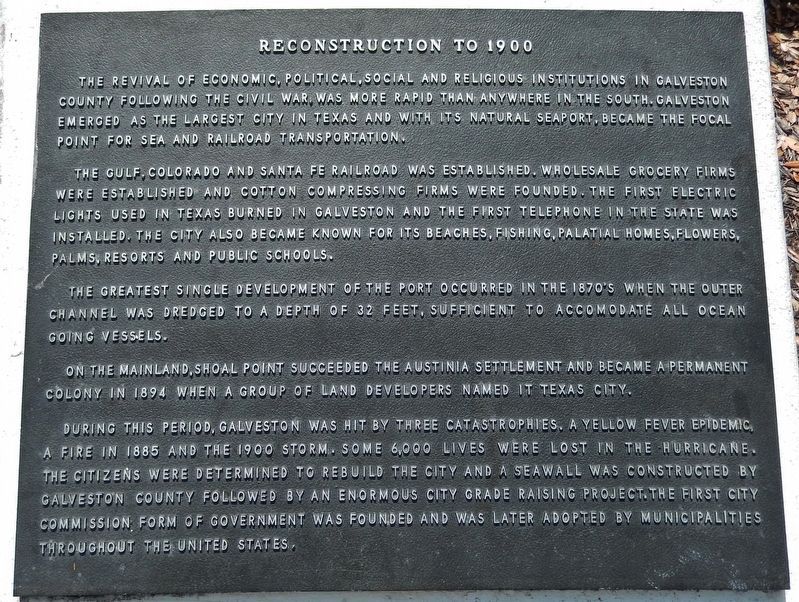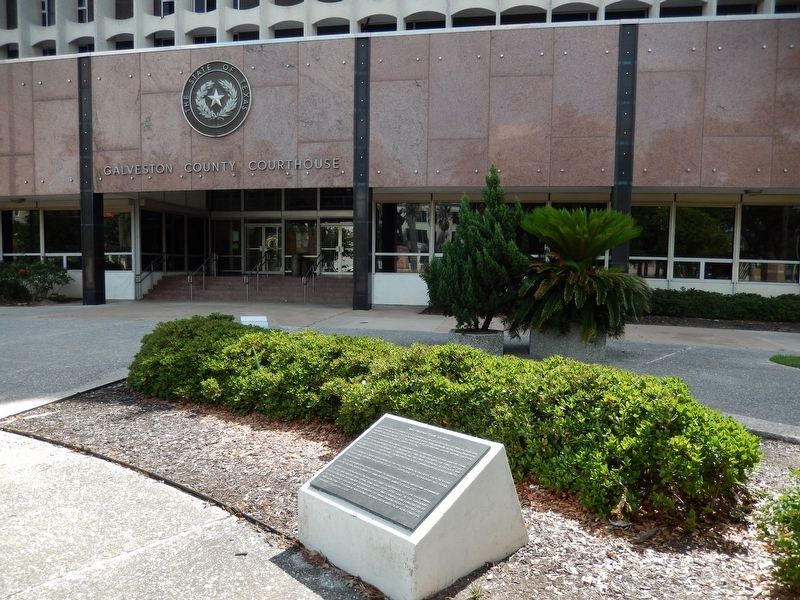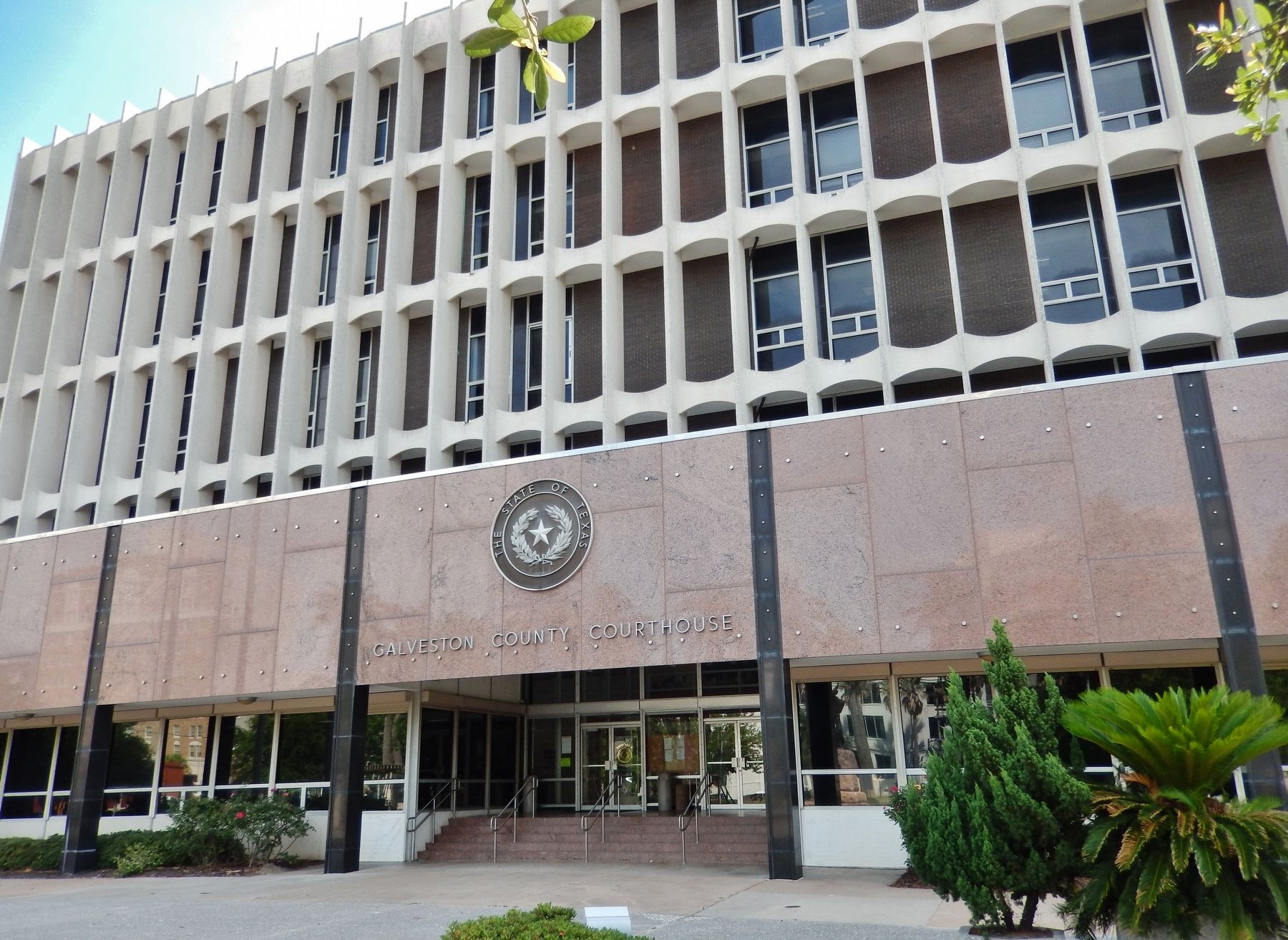Galveston in Galveston County, Texas — The American South (West South Central)
Reconstruction to 1900
The revival of the economic, political, social and religious institutions in Galveston County following the Civil War, was more rapid than anywhere in the south. Galveston emerged as the largest city in Texas and with its natural seaport, became the focal point for sea and railroad transportation.
The Gulf, Colorado and Santa Fe Railroad was established. Wholesale grocery firms were established and cotton compressing firms were founded. The first electric light used in Texas burned in Galveston and the first telephone in the state was installed. The city also became known for its beaches, fishing, palatial homes, flowers, palms, resorts and public schools.
The greatest single development of the port occurred in the 1870’s when the outer channel was dredged to a depth of 32 feet, sufficient to accommodate all ocean going vessels.
On the mainland, Shoal Point succeeded the Austinia Settlement and became a permanent colony in 1894 when a group of land developers named it Texas City.
During this period, Galveston was hit by three catastrophes, a yellow fever epidemic, a fire in 1885 and the 1900 storm. Some 6,000 lives were lost in the hurricane. The citizens were determined to rebuild the city and a seawall was constructed by Galveston County followed by an enormous city grade raising project. The first city commission form of government was founded and was later adopted by municipalities throughout the United States.
Erected 1967. (Marker Number 7464.)
Topics. This historical marker is listed in these topic lists: Disasters • Industry & Commerce • Railroads & Streetcars • War, US Civil.
Location. 29° 18.187′ N, 94° 47.383′ W. Marker is in Galveston, Texas, in Galveston County. Marker can be reached from Moody Avenue south of Winnie Street, on the left when traveling south. Marker is located on the west side of the Galveston County Courthouse grounds. Touch for map. Marker is at or near this postal address: 722 Moody Avenue, Galveston TX 77550, United States of America. Touch for directions.
Other nearby markers. At least 8 other markers are within walking distance of this marker. Texas Revolution and Civil War (a few steps from this marker); [Galveston County] 1901-1965 (a few steps from this marker); Dignified Resignation (a few steps from this marker); [Galveston County] Early History (a few steps from this marker); Texas Bar Association (within shouting distance of this marker); Norris Wright Cuney (within shouting distance of this marker); Galveston County Communities (within shouting distance of this marker); Exploration (within shouting distance of this marker). Touch for a list and map of all markers in Galveston.
Also see . . .
1. Reconstruction in Texas. The period of Reconstruction saw steady urban growth in Texas. Galveston, the principal city, had 13,818 people, and San Antonio had 12,256. Other towns were becoming cities, including Houston, Austin, and Jefferson. Galveston was the financial and cultural capital, with two national banks, a savings bank, the Galveston Medical College, a Catholic college, an opera house, two theaters, and three concert halls. By the end of Reconstruction, Galveston had its first paved streets, gas lights, and streetcars. (Submitted on June 5, 2018, by Cosmos Mariner of Cape Canaveral, Florida.)
2. Civil War and Reconstruction. When the war ended with Confederate General Robert E. Lee’s surrender at Appomattox Court House on April 9, 1865, the official news did not reach Texas for weeks. It arrived on June 19, 1865 – a day now celebrated as Juneteeth – when General Gordon Granger and Union forces landed in Galveston. They had arrived to occupy the state, and to order the emancipation of all slaves in Texas. Reconstruction had begun. Reconstruction was not an easy time for Texans. Residents had to pledge their loyalty to the United States, abolish slavery, and declare that secession from the union was illegal. For many former slaves, freedom from bondage provided limited opportunities for building new lives. (Submitted on June 5, 2018, by Cosmos Mariner of Cape Canaveral, Florida.)
3. Galveston, Texas. The city's progress continued through the Reconstruction era with numerous "firsts": construction of the opera house (1870), and orphanage (1876), and installation of telephone lines (1878) and electric lights (1883). Having attracted freedmen from rural areas, in 1870 the city had a black population that totaled 3,000, made up mostly of former slaves but also by persons who were free men of color and educated before the war. During the post-Civil-War period, leaders such as George T. Ruby and Norris Wright Cuney, who headed the Texas Republican Party and promoted civil rights for freedmen, helped to dramatically improve educational and employment opportunities for blacks in Galveston and in Texas. Galveston was a cosmopolitan city and one of the more successful during Reconstruction; the Freedmen's Bureau was headquartered here. German families sheltered teachers from the North, and hundreds of freedmen were taught to read. Its business community promoted progress, and immigrants stayed after arriving at this port of entry. (Submitted on June 5, 2018, by Cosmos Mariner of Cape Canaveral, Florida.)
Credits. This page was last revised on February 1, 2024. It was originally submitted on June 5, 2018, by Cosmos Mariner of Cape Canaveral, Florida. This page has been viewed 335 times since then and 41 times this year. Last updated on January 23, 2024, by Jeff Leichsenring of Garland, Texas. Photos: 1, 2, 3. submitted on June 5, 2018, by Cosmos Mariner of Cape Canaveral, Florida. • Bernard Fisher was the editor who published this page.


